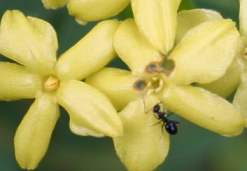Lasiosiphon triplinervis
Lasiosiphon triplinervis (Meisn.) Decne.
Family: Thymelaeaceae
Common names: None recorded
Introduction

An attractive yellow shrub that flowers throughout the year. This is one of the most underrated grassland forbs, drawing attention from a distance with its striking yellow flowers. It was previously called Gnidia triplinervis.
Description
Description
A much branched shrub with slender stems bearing small but prominent leaf scars, growing up to 200cm.The narrow alternate leaves are hairless with the midrib prominent on the underside. Bright yellow tubular flowers are borne in terminal clusters Although this shrub flowers from August to May (late winter to autumn) in its natural grassland habitat, it flowers throughout the year in the KwaZulu-Natal National Botanical Garden in Pietermaritzburg.

Conservation Status
Status
L. triplinervis is listed as "Lower Risk (Least concern)" by Scott-Shaw (1999).
Distribution and habitat
Distribution description
This species is found in coastal grasslands in Pondoland in the eastern Cape and southern KwaZulu-Natal.
Derivation of name and historical aspects
History
The previous generic name was first used by Linnaeus. Gnidia is after the Classical Greek port city of Knidos (Cnidus - today the Turkish port city of Cumali).The specific name, triplinervis refers to the three nerves visible on the underside of the leaves.
Ecology
Ecology
Small insects and bees visit the flowers, and bee specialist, entomologist Greg Davies of Natal Museum, believes that small flies may play a role in its pollination.

Uses
Use
Use of L. triplinervis for medicinal purposes has not been recorded, but some Gnidia species are used medicinally, such as Gnidia splendens which is used to treat lumbago, sore throats and snakebite. It even used as a broom. Members of the family Thymelaeaceae have tough bark which strips easily and is used for lashing bundles of wood. The bark is also stripped and strands twisted together for binding twine for thatching.
It is an excellent garden plant because of its persistent small yellow flowers, attractive ball-shape, hardiness and general frost resistance. In our garden in Pietermaritzburg we planted these small shrubs on the edge of the path that takes you to the restaurant.
Growing Lasiosiphon triplinervis
Grow
We have been growing this plant successfully in this garden for the past three years. L. triplinervis is one of the few gnidias that grows easily from cuttings. In KwaZulu-Natal National Botanical Garden in Pietermaritzburg, we have been experimenting with different methods of growing these little shrubs. Finally we achieved a good growing percentage of 75 - 85 percent by taking fresh, disease-free cuttings, without using root hormone. The cuttings are inserted in small blocks of oasis and placed in a well-drained tray. Oasis has the ability to hold water well. Sometimes we use the standard method of growing plants from cuttings by placing them in coarse to medium pine bark, again without using rooting hormone.
The cuttings are placed in a mist house with a bottom heat of ± 25ºC. The plants root within seven weeks. Once rooted they are potted with coarse pine bark which is mixed with a slow release fertilizer, and kept in a section of the mist house without bottom heating for a further one and a half weeks (about ten days), then taken out and placed under shade netting for up to six weeks before being placed in full sun or planted out in a garden.
We have not yet grown this plant from seed, because seeds of Lasiosiphon triplinervis are difficult to collect and propagation by cuttings is very successful.
References
- Cary, M. 1949. The Geographic background of Greek and Roman History. Oxford UP.
- Pooley, E. 1998. A Field Guide to Wild Flowers KwaZulu-Natal and the Eastern Region. Natal Flora Publication Trust.
- Scott-Shaw, C.R. 1999. Rare and Threatened Plants of KwaZulu-Natal and neighbouring regions. KwaZulu-Natal Conservation Service.
Credits
Senzo Khanyile
KwaZulu-Natal National Botanical Garden
January 2006
Plant Attributes:
Plant Type: Perennial, Shrub
SA Distribution: Eastern Cape, KwaZulu-Natal
Soil type: Sandy, Loam
Flowering season: Sporadic/All year
PH: Acid
Flower colour:
Aspect: Full Sun
Gardening skill: Challenging
Special Features:
Horticultural zones









Rate this article
Article well written and informative
Rate this plant
Is this an interesting plant?
Login to add your Comment
Back to topNot registered yet? Click here to register.